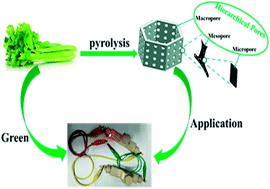Celery-derived porous carbon materials for superior performance supercapacitors†
Abstract
Supercapacitors are of paramount importance for next-generation applications, demonstrating high energy output and an ultra-long cycle life, and utilizing green and sustainable materials. Herein, we utilize celery, a common biomass from vegetables, by a facile low-cost pyrolysis and activation method for use in high-voltage, high-energy, and high-power supercapacitors. The as-synthesized hierarchically porous carbon materials with a high surface area of 1612 m2 g−1 and a large quantity of nitrogen and phosphorus heteroatoms exhibit a high specific capacitance of 1002.80 F g−1 at 1 A g−1 and excellent cycling stability of 95.6% even after 10 000 cycles (10 A g−1) in aqueous electrolytes. Moreover, the assembled symmetric cell delivers a high energy density of 32.7 W h kg−1 at 1200 W kg−1 and an ultra-high stability (loss of 4.8% after 10 000 cycles). Therefore, the outstanding electrochemical performance of the materials will be of use in the development of high-performance, green supercapacitors for advanced energy storage systems.



 Please wait while we load your content...
Please wait while we load your content...